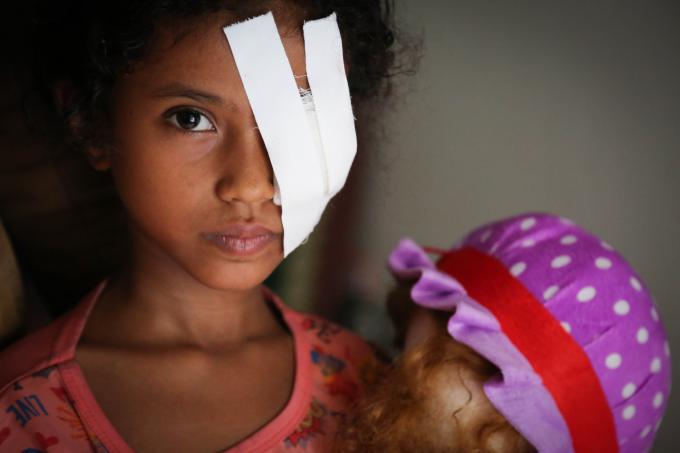Eight-year-old Razan* was badly injured after shrapnel hit her left eye as she tried to leave Hodeidah
Multimedia content available here
A fresh wave of violence that’s seen bombing escalate and deadly clashes erupt south of Hodeidah City is putting the lives of thousands of children in extreme danger, Save the Children is warning.
Even before the latest increase in violence, an average of 6,238 people—half of whom are children—were fleeing Hodeidah Governorate every single day.
In little more than 50 days (June 1st to July 24th) the constant threat of bombing, shelling, starvation and a lack of basic services displaced a total of 330,610 people from Hodeidah according to the United Nations.
The journey for those trying to flee, however, is often no safer—with families having to brave minefields, airstrikes and being forced to cross areas of active fighting all in a bid to escape the embattled governorate. Civilian casualties in the most impacted districts more than doubled in the start of July as the fighting moved to more populated areas, according to the UN’s Refugee Agency.
Eight-year-old Razan* was severely wounded in one eye after a bomb exploded nearby as she and her father tried to leave. She was in agony for days and her family feared she was permanently blinded.
Razan*’s father, Samir* said:
“When Razan* was injured, the airstrike was just metres away from us. The airstrike hit an armoured vehicle nearby and flying shrapnel hit Razan in the eye. I tried to get us to a safe place to have a look at her eye, and then I bandaged her up with my shawl. Then we had to carry on moving.”
“Razan* had to go five days without treatment, because I didn’t have enough money. After five days I asked Razan whether she could still see through her injured eye. She lied and said yes. We went upstairs, and I asked her to count the birds outside, while I covered her good eye. She said there were two, but there were four.”
Razan* eventually reached a specialist hospital, where Save the Children referred her for emergency surgery that should restore her eyesight—but there are many more children like her who are not getting the care they need.
Even if they make it out, the villages and communities where they flee to are overwhelmed and simply can’t cope with the influx of people or provide them with essential services. This is putting the whole country at risk, leaving the most vulnerable living in crowded conditions and struggling to find enough food, water or medicine to survive. This could lead to extreme food insecurity or an outbreak of cholera, measles or diphtheria, diseases that have already taken hold in Yemen and disproportionately affect weak and/or malnourished children—leaving an already weakened health system on the verge of collapse.
Save the Children’s Yemen Country Director, Tamer Kirolos, has just returned from Hodeidah. He described what he saw there:
“Since I was last here just two months ago, Hodeidah City has become somewhat of a ghost town. The streets are empty even in the day and there are checkpoints everywhere. The devastation that airstrikes and shelling have caused is clear to see.”
“Hodeidah was already the poorest governorate in Yemen—which is the poorest country in the Middle East—before this latest offensive and it simply can’t handle another blow. People fear they will die whether they stay or they flee but even if they manage to get out their lives remain in danger. With the economy in tatters and health and sanitation facilities throughout the country destroyed, conditions are now rampant for disease and starvation to spread. Aid agencies are doing what they can to keep people alive but ultimately, our efforts are just a sticking plaster on a gaping wound.”
“We must see an immediate ceasefire to avoid any more civilian casualties and we call on all parties to continue to negotiate with the UN Special Envoy Martin Griffiths in good faith, to achieve a workable peace deal that will bring an end to this brutal war and to the suffering of 22 million people in Yemen.”
ENDS
SaveChildrenYE

